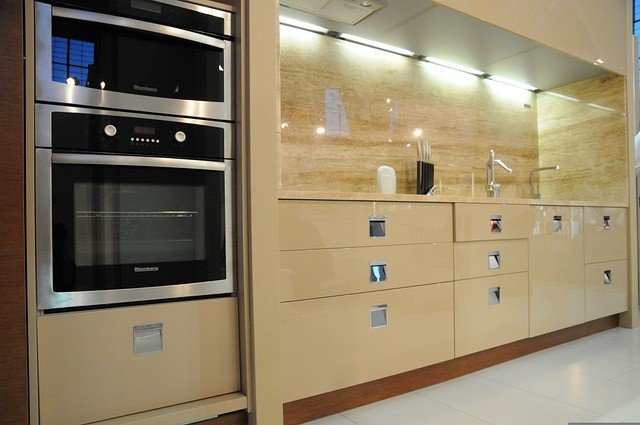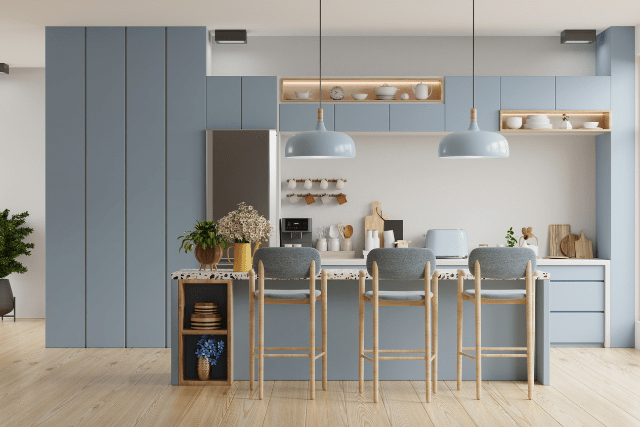In any home, the kitchen is the hub of activity. A modern urban lifestyle, changing customs, communication technology, and other factors have changed the face of modern Indian kitchens. This article aspires to create an interactive kitchen concept and employ interactive Indian Kitchen Furniture.
How the Urban Kitchens evolved?
A segment of the skilled urban population lives a nomadic existence. They move about during their studies and careers, which continues well into their early marriages.
A poll of this demographic revealed a need for furniture that can move with them and be reconfigured, i.e. modular furniture. Even though the kitchen market is expanding, there are currently no goods on the market that can fulfil the special needs of this important urban migrant group.
Traditional kitchens provide several obstacles, and a modular kitchen is a new and imaginative solution. With its functionality and durability, it’s a solution that makes ordinary kitchen duties simple. It’s a word for a modern kitchen layout that consists of modular units/cabinets built of diverse materials that house the necessary accessories.
Today’s kitchens are mostly made of fixed, hard structures rather than furnishings. Compared to current kitchen appliances, most are non-ergonomic, lack structured storage, and lack aesthetic complement.
Fast Cooking and Mobility
The architecture of today’s urban Indian homes is modern, with the latest appliances and a keen sense of change. Double-income nuclear families are becoming the norm in cities, with a significant portion of disposable cash going toward trendy furniture. It’s difficult to devote enough time to the complicated cooking process while male and female members work.
Indian kitchens are getting more structured and modern in appearance to save time and increase efficiency. Consumers who wish to cut cooking time are bringing a wide range of food processing and cooking appliances to market today. Technological advancements have changed how we buy, cook, and eat food. Indian kitchens are transforming from traditional cooktops to high-tech microwave ovens.
The expansion of the service industry has resulted in a vast pool of competent individuals in high-growth areas such as IT, Infrastructure, and other fields. In terms of lifestyle, the current population group is highly migratory. This group comprises well-educated, computer-savvy professionals riding a wave of economic expansion. Users have a global attitude, are trend-conscious, and have increasing discretionary budgets.
Users between young ages move across places for better education and work possibilities. Even though married couples and professional bachelors buy modular house furniture that they can move when they move, they cannot furnish kitchens owing to the lack of compact kitchen furniture that offers mobility.
Indian kitchens are as diverse as Indian cuisine and culture. Each kitchen has been fine-tuned to fit the specific requirements of the local food preparation. Vegetarianism is practiced by a large portion of the population.
The cooking style is determined by regional food types, community preferences, weather, and location, among other factors. The majority of Indian dishes necessitate extensive pre-processing. The meal is spicy, and the emphasis is on making the food more flavourful and fierier.

The duty of most metropolitan females in the kitchen has grown easier with contemporary food preparation tools in hand. As the global population embraces a modern consumption-fuelled lifestyle, Indian kitchens are changing. In addition, the sort of food consumed has altered.
Due to the time constraints of city life, emphasis is placed on foods that can be prepared quickly and require minimal processing time. This is the main reason behind the popularity of packaged foods such as noodles, oats, or cornflakes provided to youngsters for breakfast.
In the past, it was common to observe a wife in the kitchen giving food to family members. The dining area was combined with the kitchen area. Before leaving for work, a woman would normally give breakfast to her husband. In traditional Indian houses, men and women rarely ate together.
With the development in the level of living in India, there has been a shift in social customs and behaviours. The dining table and chairs arrangement inside the kitchen has made all family members eat together or at their own pace. The dining table is made of wooden or fibre material.
Urban Family Kitchen Requirements
Urbanization and migration to cities for better prospects have resulted in the disintegration of joint family structures in metropolitan areas, resulting in nuclear family arrangements. Instead of eating on the floor, the family eats at a dining table. Couples working in IT, software or call centres and with conflicting work schedules are likelier to prepare and eat food alone.

Small urban families with both husband and wife working nowadays prefer to spend less time cooking and more on personal amusement. In a time-crunched metropolitan existence, the availability of pre-processed packaged food is increasingly acceptable in everyday diets. Children, influenced by the media, also prefer to eat fast food for breakfast or lunch. Cooking might be a monotonous everyday activity for some people.
As a result, most of them choose to watch TV, send texts, or talk on the phone while cooking to escape the monotony. Some customers had even adjusted the direction of their televisions for greater visibility from their kitchens. Individual or family mealtime nowadays would be unthinkable for some if they were not entertained by television, radio, or music. The majority of women nowadays try to organize their daily kitchen tasks so that they can watch their favourite shows.
Putting the finishing touches on the kitchen
A kitchen is where food is stored, prepared, and cooked. A gas-fired stove or a microwave oven are common cooking appliances in modern kitchens. Refrigerator for food storage and preservation. Sink with running water and drainage for raw food cleanup and dishwashing. Food, utensils, and other cooking aids are stored in a well-organized manner in the shape of cupboards.
Although cooking is the primary function of a kitchen, it can also serve as the hub for other activities, particularly within houses, depending on its size, furnishings, and equipment. If a washing machine is available, clothes are washed and dried in the kitchen. If the kitchen is large enough, it can also serve as the family’s dining room. It is often the most welcoming room in the house, where family and visitors congregate.
Diversified Kitchen Furniture Demands
All cities and towns have a high demand for kitchen furniture. Modular kitchens are in high demand across all sectors. However, most kitchen producers only serve a small section of the market. Consumers purchased whole kitchen furnishings starting at an average price of Rs 50K and going up to 3-4 lakhs! It was vital to comprehend the market as a whole before defining a new line of items.
For both functionality and design, modular kitchens are superior. But it’s more! Easy assembly is a great feature of modular kitchens. Your modular kitchen pays you back by allowing you to move it easily. Any portion of a modular kitchen can be repaired or replaced.
Modular kitchens can be built to order. You can choose modules, colours, and styles based on your kitchen activity. Kitchens take up a lot of valuable workspaces. However, modular kitchens solve this problem. The modules maximize storage area and capacity. Shelves, cupboards, and drawers in a modular kitchen are for storage. Their storage capacity will astound you! You can clean up and store anything.
Concluding Remarks
The kitchen is one of the most important aspects of any Indian home, both in appearance and functionality! India has a long history of excellent handcrafted furniture made of teak, rosewood, and walnut wood with strong colonial roots in the decorative domestic furniture market. In India, there is a wide selection of indigenous furniture available, including both residential and contract system furniture, with an emphasis on Indian kitchen furniture these days.







